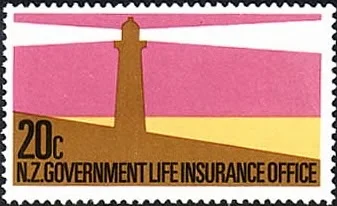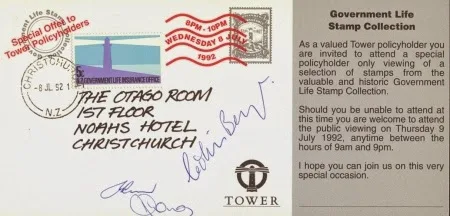.jpg) Special stamps for use solely by the Government Life Insurance Office were first issued in 1891, a lighthouse being incorporated into each stamp design. Over the years other issues continued this theme with both symbolic and actual lighthouses being shown.
Special stamps for use solely by the Government Life Insurance Office were first issued in 1891, a lighthouse being incorporated into each stamp design. Over the years other issues continued this theme with both symbolic and actual lighthouses being shown.The inclusion of a stylised lighthouse on the 1981 Government Life stamp issue continued this theme that had always appeared on Government Life stamps since their inception.
This would prove to be the final stamps issued by the Government Life Office as their postage stamps were discontinued in 1987 when Government Life Insurance became Tower Corporation. The symbol of a tower (lighthouse) was continued by the new company by their postage stamps were dropped. As can be seen below, Tower Corporation retained a large collection of stamps and other items related to Government Life Stamps.
1981 Lighthouse Issue.
The final issue of lighthouses went back to a stylised design featuring bright colours and six values. I have noticed that with some these stamps the value and company name at the bottom have proved hard to read.
3c - Blue and Mauve Lighthouse. 10c - Purple and Red Lighthouse.
20c - Pink and Yellow Lighthouse. 30c - Mauve and Light Blue Lighthouse.
40c - Orange and Yellow Lighthouse. 50c - Turquoise Blue and Green Lighthouse.
Printing Error.
This corner block of nine stamps shows the result of a mark or dirt on the printing plate. It can be found in the left-hand stamp, where a small white ring touching the right side of the lighthouse tower is visible. In other locations or on other stamp designs this might almost go unnoticed but the fact that it is touching the lighthouse adds to its interest value.
First Day Cover - 3rd June 1981.
Other Special Items.
This cover, postmarked 2nd August 1981 marks the Centenary of the Cape Egmont Lighthouse. The two stamps, a 1981 20c stylised lighthouse, and a 1969 4c - Cape Egmont Lighthouse.
This is not a postal item, its an invitation card designed to appear like a postcard. The event is a viewing of selected stamps from the valuable and historic Government Life Stamp Collection. The card includes a 1981 5c stamp which would have been discontinued by July 1992.
Technical information.
Date of Issue:
| 3 June 1981 |
|---|---|
Designer:
| A G Mitchell, Wellington |
Printers:
| Harrison and Sons England |
Stamp Size:
| 42mm x 25mm |
Sheet Size:
| 100 stamps per sheet |
Process:
| Lithography |
Perforation Gauge:
| 14.25 |
Paper Type:
| Harrison and Sons Unwatermarked |
Some of the images in this post were used with permission from the illustrated catalogue of StampsNZ
You can visit their website and On-line Catalogue at, http://stampsnz.com/










We appreciate your engagement with our content. To ensure a respectful and constructive community, please take note of the following:
- No Spam, Please: We do not tolerate spammy or promotional comments. Any such comments will be promptly removed.
- Moderation in Place: All comments are moderated to maintain a positive and inclusive environment. Please be patient, as it may take a little time for your comment to appear.
- Sign In with Google: To comment, please sign in using your Google account. This helps us maintain the integrity of our community and allows for better interaction.